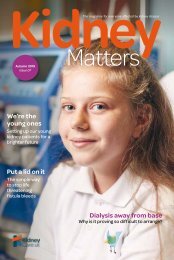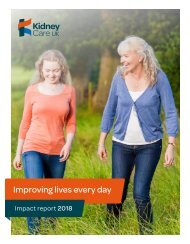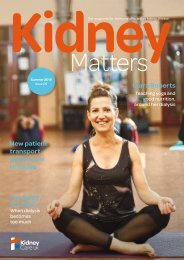Kidney Matters - Issue 14 - 2021
Kidney Matters is our free quarterly magazine for everyone affected by kidney disease. This issue includes features on whole-organ pancreas transplantation, The UK Living Kidney Sharing Scheme, how cycling 30 mins a day during each haemodialysis session can help promote a healthy heart, and an article all about skin cancer after a transplant including diagnosis, treatment and how to lower your risk. As well as this, the Kidney Kitchen features a delicious, healthier twist on homemade fish and chips with mushy peas.
Kidney Matters is our free quarterly magazine for everyone affected by kidney disease.
This issue includes features on whole-organ pancreas transplantation, The UK Living Kidney Sharing Scheme, how cycling 30 mins a day during each haemodialysis session can help promote a healthy heart, and an article all about skin cancer after a transplant including diagnosis, treatment and how to lower your risk.
As well as this, the Kidney Kitchen features a delicious, healthier twist on homemade fish and chips with mushy peas.
Create successful ePaper yourself
Turn your PDF publications into a flip-book with our unique Google optimized e-Paper software.
30
Doctor on dialysis
By Douglas Lee, Cardiology Specialist Registrar, University Hospital Coventry and Warwickshire
FEATURE INTERVIEW
We rarely look beyond the white coat when we speak to a doctor. We assume they
must be fit and well and can’t possibly understand what it feels like to have a chronic
illness, to dialyse or to wait for years in the hope that a transplant will be offered. Dr
Douglas Lee, a busy cardiology specialist registrar in Coventry, knows only too well.
Deep down I knew something was wrong. Frothy urine
and swollen ankles. My urine dipstix test indicated
that I was passing loads of protein in my urine. My
colleagues had rallied around me when I sheepishly
approached them with my symptoms. I didn’t feel
unwell, and yet I knew I could no longer hope this would
go away on its own. “Doctors don’t get unwell” and yet
they do as I can testify.
I was diagnosed with nephrotic syndrome due to focal
segmental glomerulosclerosis (FSGS) in February
2002. I remember the day well. After giving an armful
of blood for various blood tests that my junior
doctor colleagues had arranged, I had gone home in
preparation for the upcoming night shift on call. My
phone rang and I was told, “The boss wants to see
you”. I sat in front of the consultant whilst he spoke
to the renal specialist. A renal biopsy followed, then
numerous outpatient appointments and trials with
steroids and various immunosuppressive tablets, and
their side-effects.
Dialysing at home
The diagnosis
Like my fellow patients, I had googled FSGS. The
statistics didn’t make good reading – “most people
with FSGS end up on renal replacement therapy within
5 years”. And so, in 2006, after gaining a few stones
in weight from fluid retention and having stopped
peeing altogether, I went into hospital to start urgent
haemodialysis (HD). Peritoneal dialysis wasn’t an
option as my blood protein levels were too low. I had
deteriorated very quickly, too quick to allow a fistula to
develop, so a tunnelled line was inserted expertly and,
to my relief, painlessly by one of the renal specialists.
It was a strange experience being on the ‘other side’.
Being on the renal ward, the noise, the food, the wait
for the doctors’ ward round, the lack of information
and the burning desire to get home. Dietitians, renal
specialist nurses, junior and senior doctors came to
see me, most of them surprised to see a colleague
before them, and unsure how to approach the
situation. “I’ve never had to treat a doctor,” was very
common. I smiled politely and told them to assume
no prior knowledge. Reassured, they were now
comfortable to continue in their role.
Returning to work was a welcome relief from daytime
TV and a distraction from my newly acquired patient
status. Work colleagues and the hospital trust were
supportive and watchful. I was able to hide my
tunnelled line under my shirt, but the scars from
my fistula were visible for all to see. “Bare below the
elbows” cried the infection control police. Patients’
curiosity led them to enquire about my arm, and many
were surprised at the reply.
Seeing patients brought a new understanding. I could
appreciate their fears and worries, lack of sleep from
the noise, their need for information and reassurance,
and the desire, in the majority, to get back to their
own homes. After completing a ward round or an
outpatient clinic, I would take myself off to the satellite
dialysis unit, conveniently just recently opened on
site at the hospital. Even here the dialysis nurses were
nervous about needling me. “Assume I don’t know
anything” - which I didn’t, as I had never worked in a
renal unit, and had now specialised in cardiology.
Being a patient and a doctor on the renal unit or
hospital ward was at times difficult. I would never let
people know my profession unless asked. But word
gets around. It was difficult not to intervene, especially
hearing a doctor struggle with a fellow patient’s heartrelated
symptoms.
A gift from my mother
My mother gave me a precious kidney. My family and
I were hopeful that this would free me from dialysis.
But the kidney didn’t read the script, and some three
weeks later, it was removed, having never produced
www.kidneycareuk.org

















